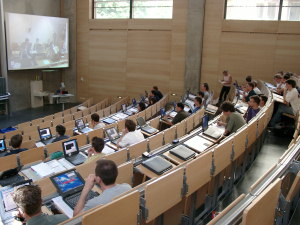Wireless Interactive Learning - Mannheim (WIL-MA)
Introduction
Conventional lectures are connected with fundamental didactic problems. Particularly in large meetings, it is difficult for the lecturer to respond to individual questions or remarks. Furthermore, it is difficult to maintain the students' attention permanently, and to enable deeper cognitive processes. From the students' point of view, communication with the instructor is very restricted in mass meetings as well.
At the University of Mannheim, we developed the new teaching-learning-scenario of the Interactive Lecture to enable a a bi-directional synchronuous communication between students and lecturer on the basis of a Wireless Local Area Network. Within this scenario, all students are equipped with handheld computers like PocketPCs or Palm PDAs and use different so called WIL-MA (Wireless Interactive Learning - Mannheim)-services which allow interactivity and adaptivity of the learning contents between all participants in lectures.
Didactic Relevance:
From a pedagogical standpoint, learning is an active process. Interactivity represents an opportunity for the learner to take a hand in shaping the informational, communicational and learning process rather than remaining a passive recipient; thus it has a great impact upon successful learning.
 |
The lack of interactivity between instructors and students, respectively among the students themselves, is one point of criticism with regard to the traditional university lecture. In large teaching scenarios, more so than in more intimate ones, it is difficult for the instructor to address individual questions or comments in any depth, or to challenge the attention of the participants by means of more thoughtful questions. Also, even when such questions or feedback do constitute an essential aspect of the lectures, problems nonetheless arise: The traditional communication aids (for example, raising of hands, interjections) are of hardly any use in a large instructional scenario, since the student who does raise his/her hand will barely be noticeable in a crowd of many others. In addition, if not all participants are to be questioned individually, the only other procedures available, if indeed there are any at all, to guarantee a comprehensive consideration of students' questions are dichotomized feedback or else more time-consuming procedures. Thus, interactive components can only be realized in auxiliary laboratory exercises or tutorials, but not in the traditional lecture.
Mobile computers with wireless network access are an innovative way to achieve interactivity. Using mobile computers, participants can forward information to fellow participants or to the instructor more rapidly, "anonymously" and in more depth. The instructor can also address the participants more rapidly and directly. Moreover, with mobile computers information can be documented in greater detail, for example for analytical purposes or for the purpose of integrating archived information into other types of knowledge transfers.
Another advantage of lectures integrating the use of wireless devices by the students is the potentially adaptive behavior of the instructor. Adaptivity refers to the adjustment to the learning environment. Interactivity and adaptivity are closely related. As the adaptivity of a system increases, its interactivity will necessarily increase as well. Adaptivity is employed in an instructional-psychological context essentially to improve the learning process. For example, the instructor adapts explanations or curricula to the learners' current state of knowledge to achieve greater efficiency and efficacy of instruction by having the learners more deeply elaborate their knowledge. Empirical findings corroborate the effects of the most diverse learning-centered measures upon learning success. For example, tuning the learning content to the interests or goals of the learners will affect their learning success positively.
In summary, the increased inclusion of students into the scenario promotes their motivation, activates them and guides/focuses their attention. This, in turn, has a positive effect upon their knowledge gains, since deeper and faster processing of knowledge can take place during the process of continuous learning.

